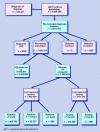Identifying undiagnosed diabetes: cross-sectional survey of 3.6 million patients' electronic records
- PMID: 18318973
- PMCID: PMC2249795
- DOI: 10.3399/bjgp08X277302
Identifying undiagnosed diabetes: cross-sectional survey of 3.6 million patients' electronic records
Abstract
Background: Around 1% of the UK population has diabetes that is either undiagnosed or unrecorded on practice disease registers.
Aim: To estimate the number of people in UK primary care databases with biochemical evidence of undiagnosed diabetes. To develop simple practice-based search techniques to support early recognition of diabetes.
Design of study: Cross-sectional survey of 3 630 296 electronic records.
Setting: Four hundred and eighty UK practices contributing to the QRESEARCH database.
Method: Electronic searches to identify people with no diabetes diagnosis in one of two categories (A and B), using the most recently recorded blood glucose measurement: random blood glucose level >or=11.1 mmol/l or fasting blood glucose level >or=7.0 mmol/l (A); either a random or a fasting blood glucose level >or=7.0 mmol/l (B). An additional outcome measure was the proportion of the population with at least one blood glucose measurement in the record.
Results: The number (percentage) identified in category A was 3758 (0.10% of the total population); the number in category B was 32 785 (0.90%). Projected to a practice of 7000 patients, around eight patients have biochemical evidence of undiagnosed diabetes, and 68 have results suggesting the need for further follow-up. One-third of people aged over 40 years without diabetes have a blood glucose measurement in the past 2 years in their record.
Conclusion: People with possible undiagnosed diabetes are readily identifiable in UK primary care databases through electronic searches using blood glucose data. People with borderline levels, who may benefit from interventions to reduce their risk of progression to diabetes, can also be identified using practice-based software.
Figures
Similar articles
-
Identifying Trends in Undiagnosed Diabetes in U.S. Adults by Using a Confirmatory Definition: A Cross-sectional Study.Ann Intern Med. 2017 Dec 5;167(11):769-776. doi: 10.7326/M17-1272. Epub 2017 Oct 24. Ann Intern Med. 2017. PMID: 29059691 Free PMC article.
-
Undiagnosed diabetes-data from the English longitudinal study of ageing.Diabet Med. 2009 Jul;26(7):679-85. doi: 10.1111/j.1464-5491.2009.02755.x. Diabet Med. 2009. PMID: 19573116
-
The potential for utilising in-hospital glucose measurements to detect individuals at high risk of previously undiagnosed diabetes: Retrospective cohort study.Diabet Med. 2022 Oct;39(10):e14918. doi: 10.1111/dme.14918. Epub 2022 Jul 26. Diabet Med. 2022. PMID: 35839301 Free PMC article.
-
Repaglinide : a pharmacoeconomic review of its use in type 2 diabetes mellitus.Pharmacoeconomics. 2004;22(6):389-411. doi: 10.2165/00019053-200422060-00005. Pharmacoeconomics. 2004. PMID: 15099124 Review.
-
FreeStyle Libre Flash Glucose Self-Monitoring System: A Single-Technology Assessment [Internet].Oslo, Norway: Knowledge Centre for the Health Services at The Norwegian Institute of Public Health (NIPH); 2017 Aug 21. Report from the Norwegian Institute of Public Health No. 2017-07. Oslo, Norway: Knowledge Centre for the Health Services at The Norwegian Institute of Public Health (NIPH); 2017 Aug 21. Report from the Norwegian Institute of Public Health No. 2017-07. PMID: 29553668 Free Books & Documents. Review.
Cited by
-
General practice at the cutting edge of information technology, or failing to keep pace?Br J Gen Pract. 2010 Apr;60(573):239-40. doi: 10.3399/bjgp10X483869. Br J Gen Pract. 2010. PMID: 20353667 Free PMC article. No abstract available.
-
Reducing the rise in type 2 diabetes.Br J Gen Pract. 2008 Aug;58(553):533-4. doi: 10.3399/bjgp08X319693. Br J Gen Pract. 2008. PMID: 18682017 Free PMC article. No abstract available.
-
Assessing electronic health record phenotypes against gold-standard diagnostic criteria for diabetes mellitus.J Am Med Inform Assoc. 2017 Apr 1;24(e1):e121-e128. doi: 10.1093/jamia/ocw123. J Am Med Inform Assoc. 2017. PMID: 27616701 Free PMC article.
-
Predicting risk of osteoporotic fracture in men and women in England and Wales: prospective derivation and validation of QFractureScores.BMJ. 2009 Nov 19;339:b4229. doi: 10.1136/bmj.b4229. BMJ. 2009. PMID: 19926696 Free PMC article.
-
Automated electronic reminders to facilitate primary cardiovascular disease prevention: randomised controlled trial.Br J Gen Pract. 2010 Apr;60(573):e137-43. doi: 10.3399/bjgp10X483904. Br J Gen Pract. 2010. PMID: 20353659 Free PMC article. Clinical Trial.
References
-
- Zimmet P, Alberti KG, Shaw J. Global and societal implications of the diabetes epidemic. Nature. 2001;414(6865):782–787. - PubMed
-
- NHS Health and Social Care Information Centre. National Diabetes Audit 2003/4. London and Leeds: NHS Information Centre; 2007.
-
- British Medical Association. Quality and Outcomes Framework. Summary of indicators — clinical domain. http://www.bma.org.uk/ap.nsf/Content/qof06~summclinical#DiabetesMellitus (accessed 3 Jan 2008)
-
- Unwin N, Shaw J, Zimmet P, Alberti KG. Impaired glucose tolerance and impaired fasting glycaemia: the current status on definition and intervention. Diabet Med. 2002;19(9):708–723. - PubMed
-
- Lindström J, Ilanne-Parikka P, Peltonen M, on behalf of the Finnish Diabetes Prevention Study Group Sustained reduction in the incidence of type 2 diabetes by lifestyle intervention: follow-up of the Finnish Diabetes Prevention Study. Lancet. 2006;368(9548):1673–1679. - PubMed
Publication types
MeSH terms
Substances
LinkOut - more resources
Full Text Sources
Medical
Research Materials
Miscellaneous


